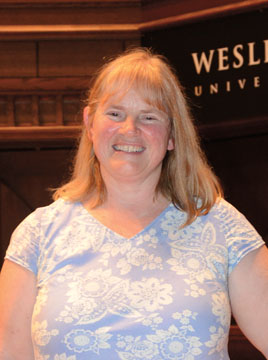RIDING HIGH WITH RYE: SIVAN COTEL ’05
Down a steep drop on an unimproved road in rural Vermont lies a picturesque 500-acre farm where Sivan Cotel ’05 is toiling with a small group of business partners to build a brand for a beverage most associated with the Roaring Twenties—rye whiskey.

Although speakeasies are long gone, rye whiskey is enjoying a comeback in popularity. For the uninitiated, think rye bread and you will get a sense that rye whiskey has a spicier taste than its vastly more popular counterpart, corn-based bourbon whiskey. Rye was once the drink of choice for whiskey consumers in the United States, but milder corn-based whiskeys gained a much stronger following during and after Prohibition.
WhistlePig came into being when Dave Pickerell, former master distiller for Maker’s Mark bourbon distillery in Kentucky, teamed up with Raj Bhakta, who had purchased the two-century-old farm in Shoreham. That Pickerell is something of a legend in the industry undoubtedly helped attract attention to the company’s first, very limited release of WhistlePig in mid-2010, which earned an impressive 96-point rating from Wine Enthusiast—the highest rating the magazine had ever given to a rye.
Artisanal foods and beverages of all kinds are the focus of intense consumer interest, and WhistlePig is trying to ride that wave. At the farm near Middlebury, beautiful fields of rye grain speak to the hope that its whiskey will be made from start to finish on site. That’s still a dream, and in the meantime, a few hundred oak barrels of rye whiskey produced by contract and imported to the farm are stacked in the barn (most of their whiskey is stored off-site). The aging and re-barreling process imparts the distinctive taste of 10-year-old WhistlePig whiskey and is the cornerstone of the company’s branding and marketing effort.
Cotel arrived at WhistlePig Farm in 2012 as an unlikely transplant from a financial job in Manhattan. After graduating from Wesleyan in 2005 with a psychology and music double major and completing a master’s degree at Wesleyan in psychology in 2006, he joined Bear Stearns. Following the financial collapse, he stayed at J.P. Morgan, which had taken over Bear Stearns.
“Very early in my career I was already dealing with some unexpected turns,” he says. “It afforded me the perspective that if one thing didn’t work out, something else would.”
From there he moved to Bank of America Merrill Lynch, eventually rising to vice president in the Global Markets Financing and Futures department.
“I tried WhistlePig at a tasting in 2010, and I earmarked it as a great whiskey,” he says. “A couple of months later I was stuck in the airport with a few friends. I happened to talk to an investor working with small consumer products, and I recommended that he look into WhistlePig. Eventually, he got back to me and said that the company was looking for investors; would I like to meet the owner, Raj Bhakta? Pretty quickly I got involved and became the first outside investor who wasn’t a ‘friends and family’ investor.”
Cotel helped Bhakta develop better supply models to accommodate multiple lines of whiskey aged for different lengths of time. Four months later, Bhakta asked him to join full time.
“I was hesitant to make a big jump. But my wife was very encouraging. She said, ‘If not now, when? We’re young, not tied down, so take a risk.’
“Next thing I knew I was CFO and COO of a small growing brand.” But he concedes that in a small business, “titles mean very little.” There is an endless amount of work to be done.
WhistlePig is not the only aged rye whiskey available, but the fledgling market is far from crowded. Not until the 1990s did rye start its comeback. Once the drink that inspired famed cocktails such as the Sazerac and the Manhattan, rye’s fall from favor after Prohibition was harsh. “It was the cheap hooch in a hip flask in 1930s gangster movies, the rotgut Ray Milland binged on in The Lost Weekend, the 1945 chronicle of an alcoholic on an epic bender. Rye had fallen from Park Avenue to Skid Row,” said writer Paul Clarke in Imbibe magazine.
Rye is back as a distinctive whiskey to use in Manhattans, and WhistlePig is benefiting from growing interest on the part of mixologists and consumers. Many brands of rye are aged for a much shorter period of time; consumers will often sample these and then seek out a better-quality brand.
 Cotel says that demand exceeds their supply, and matching production capability to the market is one of his ongoing challenges. WhistlePig is currently available in about half the country. New York, California, Texas, and Florida dominate the market with their strong cocktail cultures, but WhistlePig has yet to enter Florida. Cotel expects they will when supply increases.
Cotel says that demand exceeds their supply, and matching production capability to the market is one of his ongoing challenges. WhistlePig is currently available in about half the country. New York, California, Texas, and Florida dominate the market with their strong cocktail cultures, but WhistlePig has yet to enter Florida. Cotel expects they will when supply increases.
The team at WhistlePig had an eye-popping moment not long ago when they saw a bottle of their whiskey turn up as a prop on an episode of Breaking Bad. It turned out that the show’s creator is a fan of WhistlePig, and he provided them with an entirely unexpected and thrilling product placement. They welcome help like that because WhistlePig has no advertising budget to speak of, depending instead upon good reviews, word of mouth, and networking at industry events.
Cotel has reasons to feel encouraged. A Forbes blogger said, “According to many critics it is the best rye whiskey in the world.” Details magazine called it “America’s Best New Whiskey,” while the Wall Street Journal cited it as one of the top five whiskeys of the year. It appeared in Martha Stewart’s holiday gift guide as well as numerous others.
As for the question undoubtedly on the minds of readers—where are the pigs? The answer is that they are right outside the barn where the staff works in a converted milking parlor (no lavish overhead there). Mauve and Mortimer—two KuneKune pigs from New Zealand who have walked the red carpet at Lincoln Center for WhistlePig (and appeared at numerous other events as the brand’s ambassadors)—contentedly munch away, blithely unaware that a brand is in the making just a few feet away.
—William L. Holder ’75
Since this article was written, Cotel has left WhistlePig to co-found a new company, Stonecutter Spirits, with his wife. Both remain very fond of WhistlePig whiskey.



